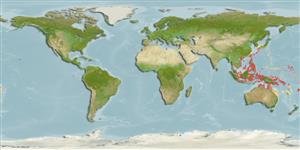>
Gobiiformes (Gobies) >
Gobiidae (Gobies) > Gobiinae
Etymology: Acentrogobius: Greek, a = without + Greek, kentron = sting + Latin gobius = gudgeon (Ref. 45335).
More on author: Herre.
Environment: milieu / climate zone / depth range / distribution range
Ecologia
marino; salmastro demersale; distribuzione batimetrica 1 - 4 m (Ref. 90102). Tropical
Western Pacific: Ryukyu Islands, Philippines, Indonesia (Ref. 559) and Papua New Guinea (Ref. 6771).
Size / Peso / Age
Maturity: Lm ? range ? - ? cm
Max length : 3.3 cm SL maschio/sesso non determinato; (Ref. 7050)
Spine dorsali (totale): 6 - 7; Raggi dorsali molli (totale): 9; Spine anali 1; Raggi anali molli: 9. Characterized by pale grey body color with brown band below eye; gill cover with dark brown streak and blue margin; head and upper half of body with irregular, brown spots and blotches; chain-link pattern at level of upper pectoral fin base to caudal base, composed of five rectangular blotches between two brown stripes, with 2-3 blue spots between each blotch; first three spines of first dorsal usually have filamentous tips; lanceolate caudal fin;, longer than head; longitudinal scale series 28-30; head without scales; ctenoid body scales; depth of body 5.3-5.5 in SL (Ref. 90102).
Inhabits silty sand and mud bottoms, usually near mouth of streams, occasionally near reefs in 1-4 m (Ref. 90102).
Life cycle and mating behavior
Maturità | Riproduzione | Deposizione | Uova | Fecundity | Larve
Masuda, H., K. Amaoka, C. Araga, T. Uyeno and T. Yoshino, 1984. The fishes of the Japanese Archipelago. Vol. 1. Tokai University Press, Tokyo, Japan. 437 p. (text). (Ref. 559)
IUCN Red List Status (Ref. 130435)
Threat to humans
Harmless
Human uses
Informazioni ulteriori
Nomi ComuniSinonimiMetabolismoPredatoriEcotossicologiaRiproduzioneMaturitàDeposizioneSpawning aggregationFecundityUovaEgg development
BibliografiaAcquacolturaProfilo di acquacolturaVarietàGeneticaElectrophoresesEreditarietàMalattieElaborazioneNutrientsMass conversion
CollaboratoriImmaginiStamps, Coins Misc.SuoniCiguateraVelocitàModalità di nuotoArea branchialeOtolithsCervelliVista
Strumenti
Special reports
Download XML
Fonti Internet
Estimates based on models
Preferred temperature (Ref.
123201): 26 - 29.3, mean 28.8 °C (based on 1331 cells).
Phylogenetic diversity index (Ref.
82804): PD
50 = 0.5000 [Uniqueness, from 0.5 = low to 2.0 = high].
Bayesian length-weight: a=0.00794 (0.00342 - 0.01847), b=3.09 (2.92 - 3.26), in cm total length, based on LWR estimates for this Genus-body shape (Ref.
93245).
Trophic level (Ref.
69278): 3.2 ±0.4 se; based on size and trophs of closest relatives
Resilienza (Ref.
120179): Alto, tempo minimo di raddoppiamento della popolazione meno di 15 mesi (Preliminary K or Fecundity.).
Fishing Vulnerability (Ref.
59153): Low vulnerability (10 of 100).
